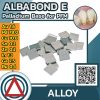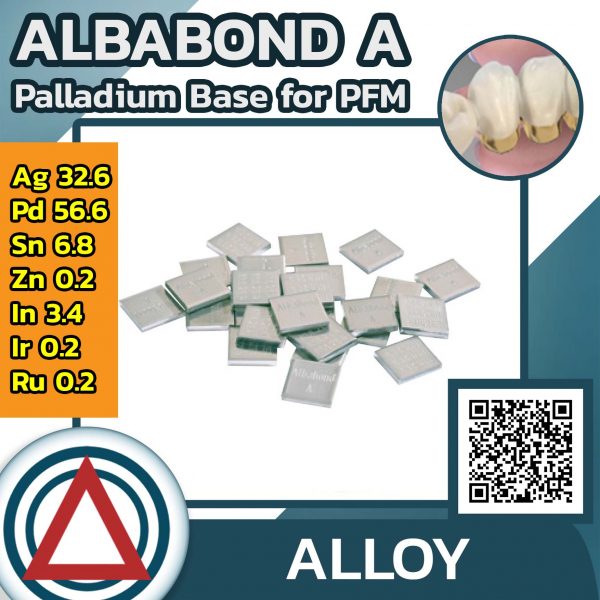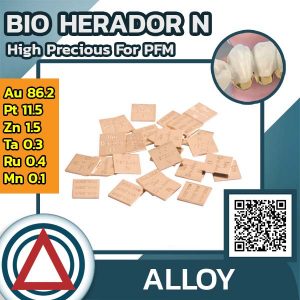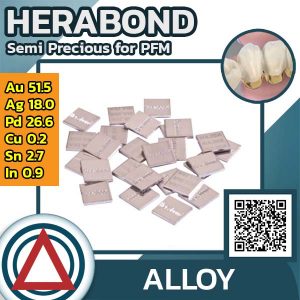Albabond A (ราคาปรับตามราคาตลาดโลก)
PD-Based Ceramic Bonding Alloy (สีขาว)
EN ISO 9693 and 22674
ข้อได้เปรียบ
– เหมาะกับงานที่ใช้ Ceramic Veneer ทั้งหมด โดยเฉพาะ PFM
– มีส่วนผสมของ silver
ประเภทงานที่เหมาะ
– Crowns
– Bridges
– Milling procedures
– Implants
แอดไลน์เพื่อสอบถามราคาและโปรโมชั่น
Add to Wishlist
Add to Wishlist
Description

| Ceramic firing | |
| CTE | 14.7 |
| Oxide firing | 880 ° C/ 5 min (stripping) |
| Soft annealing | — |
| Hardening | 600 ° C/ 15 min. |
| Solder/laser welding wire | |
| Solder | Herador solder 1100, 1070, 1060, 1060 SHerador solder V 800 |
| Laser welding wires | Albabond B |
| Ceramic bonding alloy acc. to EN ISO 9693 EN ISO 22674 |
|
| Type | 4 (s/ v/ k) |
| Shade | White |
| Indication | 3,4,5,15 |
| Composition | Ag 32.6 Pd 56.6 Sn 6.8 Zn 0.2 In 3.4 Ir 0.2 Ru 0.2 |
| Technical specifications, melting and casting | |
| Melting range | 1165 ° – 1285 ° C |
| Preheating temperature | 900 ° C |
| Casting temperature | 1440 ° C |
| Crucible | Ceramic |
| Density | 11.4 g/cm3 |
| Hardness (HV5) | 205 (w/k), 235 (v), 220 (s) |
| 0.2 % yield strength (MPa) | 460 (w/k), 540 (v) |
| Elongation (%) | 26 (w/k), 18 (v) |
| Young’s modulus of elasticity (GPa) | 122 |
x = content < 0.1 mass%
Indications:
1 Inlays, cervical filling
2 MOD Inlays
3 Crowns
4 Bridges
5 Milling technique
6 Partial dentures
10 Cast posts
14 Can be veneered with high expansion, low-fusing ceramics
15 Implant restorations
16 Electroformed double crown technique (primary crowns)
Footnotes:
w = after soft annealing and quenching
k = ceramic bonding alloy: condition after ceramic firing
v = after hardening
s = self-hardening after slow cooling in the mould
A = A stable framework design with reinforced connections with a cross section of 8 – 10 mm² is required for long span bridges and superstructures. Additionally, the frameworks need to be hardened.
B = Depending on the copper content, in some cases discolouration ofdouble crowns may result after short period of wearing. Discolouration, however, is technically and physiologically harmless.
C = In exceptional cases these alloys can also be used for traditional telescopic crowns with parallel walls and for the bar casting technique provided that cross-sections for crown walls, approximal areas, bars and laser welded joints are particularly thick and the alloy is hardened subsequently. No indication for conical crowns and sheardistributors.
Indications:
1 Inlays, cervical filling
2 MOD Inlays
3 Crowns
4 Bridges
5 Milling technique
6 Partial dentures
10 Cast posts
14 Can be veneered with high expansion, low-fusing ceramics
15 Implant restorations
16 Electroformed double crown technique (primary crowns)
Footnotes:
w = after soft annealing and quenching
k = ceramic bonding alloy: condition after ceramic firing
v = after hardening
s = self-hardening after slow cooling in the mould
A = A stable framework design with reinforced connections with a cross section of 8 – 10 mm² is required for long span bridges and superstructures. Additionally, the frameworks need to be hardened.
B = Depending on the copper content, in some cases discolouration ofdouble crowns may result after short period of wearing. Discolouration, however, is technically and physiologically harmless.
C = In exceptional cases these alloys can also be used for traditional telescopic crowns with parallel walls and for the bar casting technique provided that cross-sections for crown walls, approximal areas, bars and laser welded joints are particularly thick and the alloy is hardened subsequently. No indication for conical crowns and sheardistributors.







